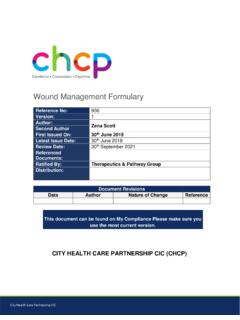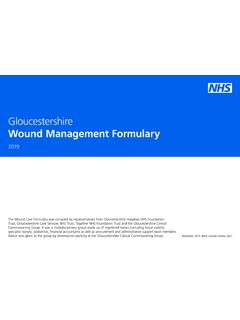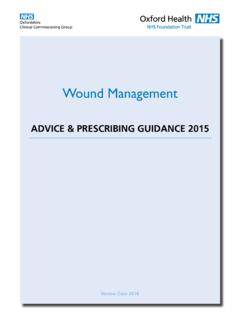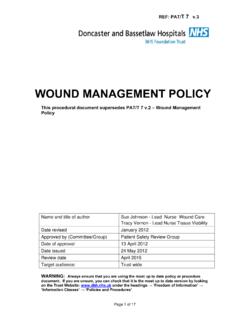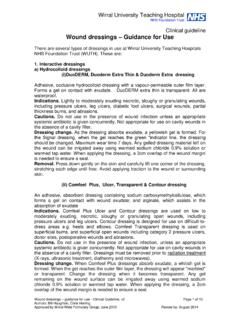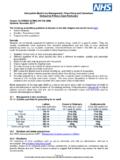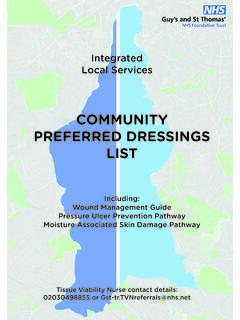Transcription of Wound Management Formulary Delay Factors
1 Page 135. Factors delaying Wound healingMany Factors have been recognised that reduce or Delay healing, the following areidentified as some of the main causes for Delay in Wound healing. Poor circulationDelayed healing and tissue breakdown is frequently associated with poor circulation. Thismay be due to local pressure, vascular disease or diabetes. Poor nutrition/malnutritionNutrition has a significant impact on Wound healing. Lack of protein will result ininsufficient building blocks for cell regeneration. Deficiency of vitamin C which is essentialfor collagen synthesis, will Delay deficiency will cause slowing down of epithelialisation and collagen synthesis. Drug therapyAnti inflammatory drugs suppress initial inflammatory process.
2 Systemic and topicalcorticosteroids can suppress both multiplication of fibroblasts and the immune system. Immune responseAllergy to topical applications, iodine may Delay healing. Irritants and allergensinclude lanolin (wool alcohols), topical antibiotics, emulsifiers such as cetyl alcohol,rubber, parabens group of preservatives, colophony, fragrance mix or balsam of Peru. AgeCell replication is slower (senescence) and the skin s resistance to injury decreases withincreasing age. ObesityAdipose tissue has poor vascularity. No known mechanism is responsible for increasedinfection and Wound breakdown in obese surgical patients, but these patients are at highrisk of postoperative Wound problems. PsychologicalIncreases in hormone levels, particularly glucocorticoids (occurring in stress and anxietyfor example) may suppress the inflammatory phase and affect healing in both acute andchronic wounds.
3 Reducing stress has been demonstrated to reduce postoperative woundinfection. InfectionLocal or systemic infection inhibits healing. Resistance to infection is related tophysiological ability and the patient s physical health. Bacterial toxins are potent inhibitorsof healing. Some have more devastating effects than others. MoistureExposure to excessive exudate can be associated with other clinical issues in chronicwounds. It may result from increased bacterial burden related to local Wound managed urinary and faecal incontinence can have a devastating effect on theskin integrity and represents a significant threat to the peri-anal skin. In severe cases, theskin can also be so badly damaged that a moisture lesion develops.
4 These are painfuland require prompt treatment to prevent them growing in 14 TemperatureThe optimum temperature for cellular activity and division is 37 C. Frequent dressingchanges, application of cold solution and leaving the Wound exposed can decrease thelocal temperature. ChemicalInappropriate use of chemicals, for example, dyes or antiseptics, can damage the woundand retard healing. This practice should be discouraged. MechanicalUnnecessarily disturbing the Wound bed can damage the developing granulation dressings can also damage the granulation tissue. Mechanical cleansing ofthe Wound is not required. MalignancyMalignancy can inhibit healing as can a range of anti-neoplastic therapies Drug TherapySome medication has the potential to cause ulceration Nicorandil.
5 Sensory NeuropathySensory loss as a result of diabetic peripheral neuropathy is a major factor contributing tofoot ulceration, 15% of diabetic neuropathy sufferers develop foot ulcers (Bild et al(1989)cited in Baker et al (2005). Sensory neuropathy can have other causes and the foot is atrisk due to the loss of protective sensations. Damage to the tissues happens and thepatient less likely to limit function due to the lack of pain from the Wound , they are morelikely to underestimate the seriousness of the pain in a foot that normally has no sensation can be a sign of infection and should benoted and investigated. Local factorsPoor surgical technique such as over use of diathermy or poor choice of suturing materialare among Factors that will Delay healing of a surgical Wound (Leaper and Gottruo 1998)Poor assessment or some Wound care practices may predispose to delayed or choice of Wound dressing, the use of fibre shedding materials like cottonwool or gauze swabs, tight bandaging can all lead to deterioration in the Wound .)
6 General factorsPoor assessment of the cause of the Wound can lead to inappropriate treatment and thiswill lead to poor healing. Any deterioration in the patients overall health adversely affectshealing. PainAll wounds have the potential to cause pain, and the nature of the pain varies with thetype of Wound . Many Factors may exacerbate pain, including infection and dressingchange. Inadequately managed pain can lead to adverse physical and psychologicalpatient outcomes. Continuous, unrelieved pain activates the pituitary-adrenal axis, whichcan suppress the immune system and result in post-surgical infection and poor woundhealingPage 15 Continuous, unrelieved pain also affects the psychological state of the patient and familymembers.
7 Common psychological responses to pain include anxiety and inability to escape from pain may create a sense of helplessness and evenhopelessness, which may predispose the patient to a more chronic depression (Wells etal 2008) Other Smoking
